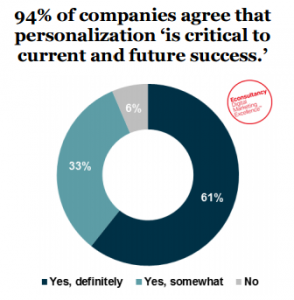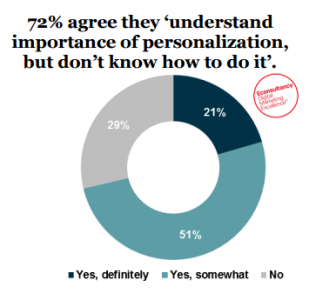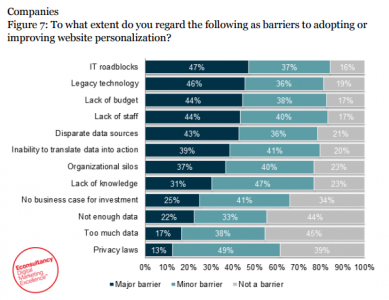Personalization: Separating the Hype from Reality

“Personalization” is the most frequently mentioned buzzword in industry articles, vendor marketing, client meetings, RFPs and at conferences. Yet very few people are actually doing it and even fewer understand what it really entails. Personalization is often spoken about in generalities, as if it’s a basic requirement. This mindset is symptomatic of the hype that surrounds the notion of dynamic personalization. The reality is that full-on personalization is complex and time consuming. It’s not a point-in-time implementation. It’s not a feature that you “turn on”.
The Hype Around Personalized Experiences
First, let’s first look at where the hype is coming from:
- Providers are selling the dream. I challenge you to find any marketing technology product or service company that isn’t banging the drum of personalized or predictive experiences. Everything is about context and engagement, coupled with descriptors like speed, agility and automation. It’s buzzword bingo and customers are buying it. Who doesn’t want a magical solution that reads the minds of your customers and reacts to their wants and needs at every turn?
- Everything and everyone is digital. Millennials live on their phones. Babies are using iPads. Software is eating the world. Big data has arrived. The “Internet of Things” is coming to your refrigerator and washing machine. With all the advancements in technology there’s a pervasive assumption that the technology can do anything we can imagine. It stands to reason that people assume that there is a piece of software that will handle personalization.
- Amazon and Netflix. These two case studies have been run ragged as anecdotal examples of algorithmic personalization. How many companies out there have mega-million dollar budgets with teams of engineers and statisticians running experiments on details like the color or shape of a button? How many companies are selling consumer-specific products at towering scale? These case studies are not relevant for most businesses. While they’re fascinating stories, they’re not realistic models to follow for the typical company or marketer.
I could rattle off a dozen more examples of personalization hype, but the point is that it’s easy for someone to get the impression that “everyone else is doing it, so I should too.” Conformity is a powerful force in business. It can also lead you off a cliff if you don’t understand the path you’re following.
The Reality of Implementing Personalization
A better look at the gap between personalization hype and reality is demonstrated by the data gathered from the "Realities of Online Personalization" study from Econsultancy.

If you feel like you’re behind the curve with personalization, this should make you feel better: Automated personalization is not being employed by the bulk of businesses, big or small.
Just because “94% of marketers agree that personalization is critical to current and future success,” it doesn’t make it so. It just means that they’re believing the hype (or they’ve been going to the same conferences I have).
The hype isn’t total b.s. Personalization is a viable and critical component to success for many digital marketers and it will continue to proliferate over time. But it’s just a facilitation tool like any other. All the hype is telling us is that the demand is there. Reality is telling us that not many know how to fulfill it. Only 4% of companies report that their customer experiences are “very personalized”.
By now you probably think this article makes the current state of personalization sound pretty grim. If not, let me seal the deal:

- 94% of companies say that personalization is critical to success.
- 72% of companies understand the importance of personalization, but they don’t know how to do it.
- Only 15% of companies state that they’re “definitely getting good ROI from personalization.”
- 41% report that “personalization hasn’t yielded dividends.”
- In another survey by Adobe, a majority of companies surveyed spend 5% or less of their marketing budget on these activities.
So even among the companies that claim to be actually doing personalization (which is only about 4%), a good chunk of them (41%) can’t attribute good ROI to it? So much for the hype.

images source: Realities of Online Personalization Study by Econsultancy
Check out the reasons (in this next graph) that companies believe they haven’t been able to realize the dream, cited as perceived barriers to personalization.
IT roadblocks and legacy technology are the top two barriers reported. While these are the perceptions, they likely aren’t the real barriers. There are thousands of businesses with capable technologies at their fingertips and only a small fraction of them are personalizing experiences for their users/customers.
The Real Barriers
The real barriers to personalization stem from the hype. It causes many to think about personalization the wrong way, putting it further out of reach. People and companies are usually turned on to personalization via a product demo, or a case study about a company who has achieved success with it. It’s shown in all its glory as polished functionality that has been planned, architected, implemented and optimized. A product company selling technology that has personalization capabilities probably isn’t going to talk about the months/years of effort and cost that goes into achieving it. On introduction it’s viewed as a technology feature, instead of what it really is: a never-ending journey.
"The real barriers to personalization stem from the hype. It causes many to think about personalization the wrong way, putting it further out of reach."
Let’s put technology and budgets aside for moment and assume those are not the real barriers. So what then?
The biggest challenge facing most organizations is that they don’t have a starting point. You can’t just dive into things like algorithmic rules and optimized content. In fact, you shouldn’t even start out thinking about automated personalization. You should start by optimizing the traditional techniques and maximizing those first. Start with the basics, which I’ll highlight below.
Take the time to perform deep audience research and map out detailed customer journeys. Closely studying the users – what they want and how they behave - will reveal that there’s a whole lot more you could be doing to optimize the experience. Things like navigational paths, user experience, and content messaging will yield far higher returns than personalization will, with less effort and cost. Content and messaging is probably the biggest challenge you’ll face. It takes a lot of time and research to get it right and make sure it resonates and drives the right behaviors. Which brings us to another major barrier to personalization: producing content.
If you haven’t yet created the optimal experience for the known audience, how can you expect to do it for the unknown audience? In order to have 1:1 conversations with the user through personalized experiences you’ll need to spend a lot of time creating and testing content for each scenario. Most organizations haven’t yet formulated a sound content strategy for their static sites, so they won't get very far with attempting dynamic personalization.
Your personalization strategy needs to be coupled with an operational plan. On the other end of personalized experiences are people who create, nurture and maintain them. The volume of content will multiply when you’re doing personalization, so you’ll need a plan for how it will be created. Workflow, governance and staffing are all critical components. Skillsets will shift as well, since you’ll need people who know how to work with data, run tests and draw actionable insights from the results. It will require more tech savvy marketers who are comfortable working with a variety of tools and software programs.
Hopefully by now your personalization expectations are more in line with reality. Now let’s look at a more pragmatic approach.
The Responsible Marketer’s Guide to Personalization
Here’s a simplified framework for approaching personalization:
- Research your audience. And then keep studying them forever, since their behaviors will change over time. Don’t assume anything about your audience that isn’t provable with statistically significant evidence. If you have to assume something, assume that what you think you know about them is wrong. Interview actual users. Run user tests based on controlled experiments. Perform periodic surveys to measure changes over time. Track, gather and report on detailed qualitative and quantitative data. Form hypotheses and then test them until they’re proven. Without reliable and accessible data, you’ll never be successful with personalization. Don’t underestimate the challenges with managing the data.
- Develop Useful Segments and Personas. Most people throw around personas loosely. They use basic models like “soccer mom”, “tech geek”, or “millennial”. These are stereotypes, not personas. There are many different ways to approach personas and segmenting, so be sure to first understand which method you’ll adopt and why. Here’s a good place to start to learn about personas.
- Create Customer Journey Maps. If you’re not familiar with customer service mapping, then stop reading about personalization and shift your attention here. Consider this an absolute prerequisite to doing any form of personalization. If you don’t know what your customers are actually doing, thinking and feeling at each moment of their journey (which goes far beyond your website), then you’ll likely be wasting your time with attempting dynamic personalization.
- Identify Meaningful KPIs. If page views and bounce rates are your measures of success you should consider hiring an analytics consultant. Key Performance Indicators (KPIs) can be impactful or trivial, depending on how you approach them. Good KPIs will often require a lot of soul searching within your organization. They’re also not always easy to measure (hint: it’s not always about revenue), but rest assured that everything is measurable.
- Produce Kickass Content. There is no magic potion for this one. Creating content is hard work. Creating great content is a beastly challenge. It starts with a dense content marketing plan and it ends with talented authors. Quality content creation is always a struggle for organizations, but without it you’re wasting your time doing anything else.
- Run Controlled Experiments. A great way to dabble in personalization without a big investment is to run some experiments. Try out an A/B split testing tool (like Optimizely or many others) to see if you can find some ways that personalization might work. If that’s out of reach for some reason, you can try to do it manually - split your email list and send out two variations of the same offer. By feeding alternating content to different users you’ll be able to measure whether or not it’s effective. Just make sure you’re using best practices when analyzing the results.
- Personalize. Once you’ve mastered steps 1 through 6 you’ll know where you should personalize, how you should do it, and what results you can expect. You’ll also know what kind of technology or tools you’ll need in place to do it.
The point of the steps above should be obvious; it’s demonstrative of the level of effort and the depth of work required to successfully incorporate dynamic personalization in your marketing practices. There are some short-cuts you can take to check the box that says “yes we use personalization”, but whether that’s meaningful and productive is up to you to decide.
Personalization is Within Reach
Think of personalization as a way to crack the ceiling once you’ve maximized your goals using traditional techniques. If you’ve optimized your content, perfected your user journeys, and card-sorted your way to a user-centered taxonomy, then you might be ready for dynamic personalization. By then you’ll have a clear understanding of where the opportunities lie that would benefit from personalization. You’ll have strong foundations and benchmarks for measurement so that when you finally implement that first personalization rule, you’ll know how much (or how little) ROI it yielded. The real barriers you’ll need to overcome are in the areas of culture, people and content - not technology.



